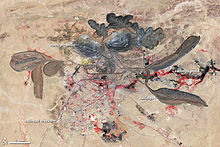16 de des. 2014
4 de des. 2014
2 de des. 2014
Tierras Raras
http://www.minas.upm.es/actualidad/noticias/1112-por-que-hablamos-hoy-de-las-tierras-raras.html
http://www.conama2014.conama.org/web/es/prensa/noticias/-es-necesario-que-vibre-nuestro-movil-.html
http://www.conama2014.conama.org/web/es/prensa/noticias/-es-necesario-que-vibre-nuestro-movil-.html
Environmental considerations[edit]
Mining, refining, and recycling of rare earths have serious environmental consequences if not properly managed. A particular hazard is mildly radioactive slurry tailings resulting from the common occurrence of thorium and uranium in rare earth element ores.[64] Additionally, toxic acids are required during the refining process.[16] Improper handling of these substances can result in extensive environmental damage. In May 2010, China announced a major, five-month crackdown on illegal mining in order to protect the environment and its resources. This campaign is expected to be concentrated in the South,[65] where mines – commonly small, rural, and illegal operations – are particularly prone to releasing toxic wastes into the general water supply.[15][66] However, even the major operation in Baotou, in Inner Mongolia, where much of the world's rare earth supply is refined, has caused major environmental damage.[16]
http://en.wikipedia.org/wiki/Rare_earth_element
Recycling[edit]
Another recently developed source of rare earths is electronic waste and other wastes that have significant rare earth components. New advances in recycling technology have made extraction of rare earths from these materials more feasible,[55] and recycling plants are currently operating in Japan, where there is an estimated 300,000 tons of rare earths stored in unused electronics.[56] In France, the Rhodia group is setting up two factories, in La Rochelle and Saint-Fons, that will produce 200 tons of rare earths a year from used fluorescent lamps, magnets and batteries.[57][58]
Subscriure's a:
Missatges (Atom)
